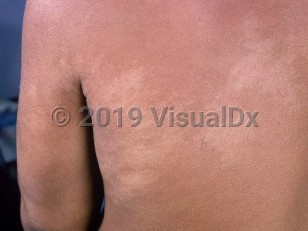Nevus depigmentosus in Child
Alerts and Notices
Important News & Links
Synopsis

Nevus depigmentosus (also known as nevus achromicus) is a common congenital disorder characterized by focal nonprogressive hypopigmentation that remains stable in its shape and distribution throughout life, although its size typically grows in proportion to overall body growth. Nevus depigmentosus typically presents at birth (0.5%-1.25% of neonates) or at a very early age, usually before 3 years. Although there are reports of nevus depigmentosus arising later in childhood, it is difficult to determine whether the lesions had actually been present prior to their discovery because of the lack of color contrast in infants with untanned skin.
Most patients will have just one macule or patch, although there are reports of patients having as many as 10. In cases where there are numerous lesions, other diagnoses should be considered. There are no particular sites of predilection.
Nevus depigmentosus is distinguished from vitiligo by a very different clinical course. Vitiligo is an acquired (and not congenital) pigmentary disorder with an unpredictable natural course, with individual lesions presenting abruptly, which may progress or regress. Lesions in vitiligo are depigmented, whereas lesions in nevus depigmentosus are hypopigmented. Furthermore, the distribution of vitiligo is symmetric, with predilection for the face and areas subject to repeated friction, such as hands, feet, and genitals.
There are no associated systemic abnormalities with nevus depigmentosus, and lesions do not have malignant potential.
Most patients will have just one macule or patch, although there are reports of patients having as many as 10. In cases where there are numerous lesions, other diagnoses should be considered. There are no particular sites of predilection.
Nevus depigmentosus is distinguished from vitiligo by a very different clinical course. Vitiligo is an acquired (and not congenital) pigmentary disorder with an unpredictable natural course, with individual lesions presenting abruptly, which may progress or regress. Lesions in vitiligo are depigmented, whereas lesions in nevus depigmentosus are hypopigmented. Furthermore, the distribution of vitiligo is symmetric, with predilection for the face and areas subject to repeated friction, such as hands, feet, and genitals.
There are no associated systemic abnormalities with nevus depigmentosus, and lesions do not have malignant potential.
Codes
ICD10CM:
L81.8 – Other specified disorders of pigmentation
SNOMEDCT:
403541001 – Nevus depigmentosus
L81.8 – Other specified disorders of pigmentation
SNOMEDCT:
403541001 – Nevus depigmentosus
Look For
Subscription Required
Diagnostic Pearls
Subscription Required
Differential Diagnosis & Pitfalls

To perform a comparison, select diagnoses from the classic differential
Subscription Required
Best Tests
Subscription Required
Management Pearls
Subscription Required
Therapy
Subscription Required
References
Subscription Required
Last Updated:11/16/2017

